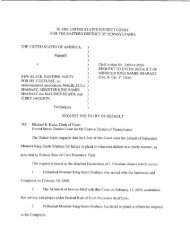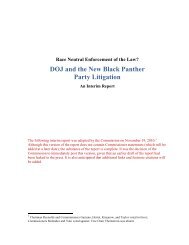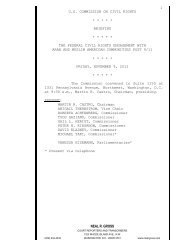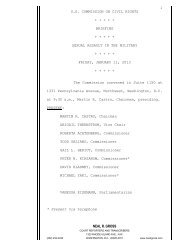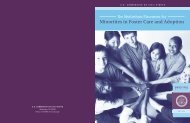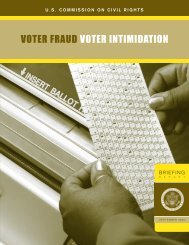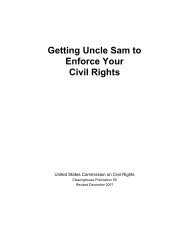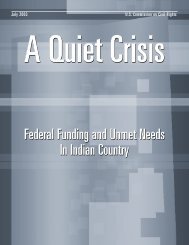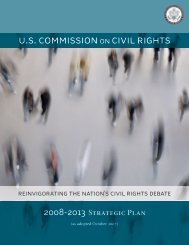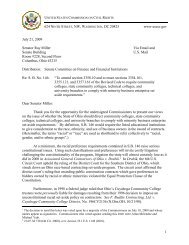The Educational Effectiveness of Historically Black Colleges and ...
The Educational Effectiveness of Historically Black Colleges and ...
The Educational Effectiveness of Historically Black Colleges and ...
You also want an ePaper? Increase the reach of your titles
YUMPU automatically turns print PDFs into web optimized ePapers that Google loves.
6 <strong>The</strong> <strong>Educational</strong> <strong>Effectiveness</strong> <strong>of</strong> <strong>Historically</strong> <strong>Black</strong> <strong>Colleges</strong> <strong>and</strong> Universities<br />
Dr. Kim pointed out that these findings showed that an African-American student’s attendance<br />
at an HBCU or an historically white college or university did not affect his or her academic<br />
success <strong>and</strong> early career earnings. She said that her findings along with those <strong>of</strong> others “lend<br />
support to the proposition that HBCUs contribute significantly to higher education in this<br />
country <strong>and</strong> merit strong support.”<br />
<strong>The</strong> discussion began with Commissioner Kirsanow commenting on Dr. Kim’s research. He<br />
noted that Dr. Kim did not control for regional effects in her study. Nonetheless, given HBCUs<br />
lower funding levels <strong>and</strong> the academic under-preparedness <strong>of</strong> their students on admission,<br />
such institutions were “doing a much better job than historically white colleges <strong>and</strong><br />
universities in educating African-American students,” he said, more than the findings <strong>of</strong> no<br />
significant difference suggest. Dr. Sullivan stated that Spelman College’s graduation rate <strong>of</strong> 77<br />
percent exceeds those <strong>of</strong> several respected <strong>and</strong> well-resourced white institutions. He added that<br />
Morehouse School <strong>of</strong> Medicine students performed better on the United States’ Medical<br />
Licensing Examination than the country’s other medical students despite scoring lower on<br />
SATs. Dean Pierce pointed out that in 2005, despite fewer resources <strong>and</strong> pre-entry academic<br />
pr<strong>of</strong>iles predicting lower achievement, graduates <strong>of</strong> North Carolina Central University School <strong>of</strong><br />
Law achieved a first-time bar passage rate <strong>of</strong> 81 percent, which tied with that <strong>of</strong> Duke<br />
University School <strong>of</strong> Law. Vice Chair <strong>The</strong>rnstrom expressed admiration for HBCUs. During a<br />
visit to Savannah State University some years ago, she noted that many <strong>of</strong> its African-American<br />
students have limited academic skills, a reflection <strong>of</strong> the “racial gap in academic achievement at<br />
the end <strong>of</strong> high school.” She was impressed by the quality education the institution <strong>of</strong>fered <strong>and</strong><br />
its dedicated efforts to improve students academically.<br />
Commissioner Kirsanow found it striking that HBCUs awarded 40 percent <strong>of</strong> all black graduate<br />
STEM degrees. Further, he observed that the top 30 HBCUs graduated the largest numbers <strong>of</strong><br />
blacks who enrolled in STEM doctoral programs. In the same vein, the Elliott, et al., article<br />
reported that despite generally weak pre-college academic credentials, HBCUs produced 40<br />
percent <strong>of</strong> black science <strong>and</strong> engineering degrees even though they enrolled only 20 percent<br />
<strong>of</strong> the total black undergraduate students. 12 Elliott <strong>and</strong> his coauthors also commented that <strong>of</strong><br />
the top 21 undergraduate producers <strong>of</strong> black doctoral graduates during the period 1986–1993,<br />
17 were HBCUs. 13<br />
Panelists <strong>of</strong>fered several suggestions for HBCUs’ educational success with students whose precollege<br />
pr<strong>of</strong>iles are not sterling. Dr. Sullivan suggested that faculty commitment played a role.<br />
Pascarella, J. Smart, C. Ethington, <strong>and</strong> M. Nettles, in American <strong>Educational</strong> Research Journal, 24 (1), 1987, pp.<br />
49-77. Kim written statement, pp. 46, 56–57.<br />
12 Rogers Elliott, A. Christopher Strenta, Russell Adair, Michael Matier, <strong>and</strong> Jannah Scott (1996), “<strong>The</strong> Role <strong>of</strong><br />
Ethnicity in Choosing <strong>and</strong> Leaving Science in Highly Selective Institutions,” Research in Higher Education,<br />
Vol. 37, No. 6, p. 700, citing <strong>The</strong> College H<strong>and</strong>book, for example, 1988, or any recent edition; Barron’s<br />
Pr<strong>of</strong>iles <strong>of</strong> American <strong>Colleges</strong>, for example, 1988, or any recent edition; E. Culotta (1992), “<strong>Black</strong> colleges<br />
cultivate scientists,” Science 258: 1216–1218 <strong>and</strong> T. R. Phillips (1991), ABET/EXXON Minority Engineering<br />
Student Achievement Pr<strong>of</strong>ile.<br />
13 Rogers Elliott, A. Christopher Strenta, Russell Adair, Michael Matier, <strong>and</strong> Jannah Scott (1996), “<strong>The</strong> Role <strong>of</strong><br />
Ethnicity in Choosing <strong>and</strong> Leaving Science in Highly Selective Institutions,” Research in Higher Education,<br />
Vol. 37, No. 6, p. 700, citing D. H. Thurgood <strong>and</strong> J. E. Clark (1995, Table 5), Summary Report 1993: Doctorate<br />
Recipients from United States Universities. Washington, DC: <strong>The</strong> National Academy Press.




